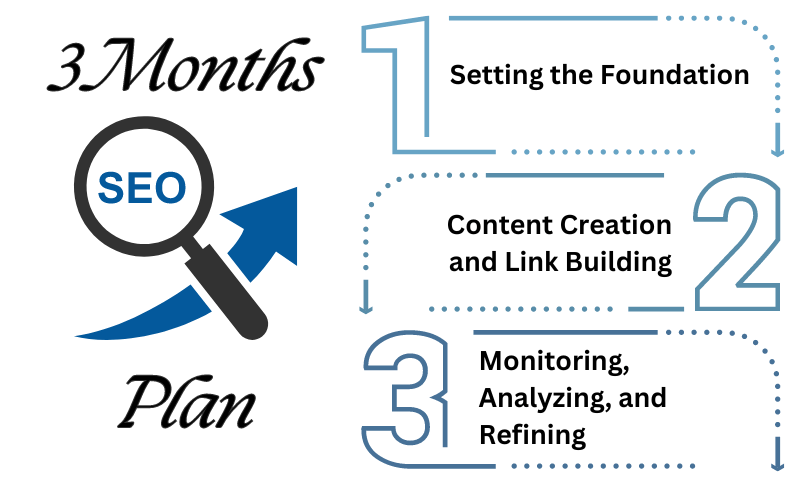When it comes to building an effective SEO strategy, having a structured plan is essential. Over the years, I’ve learned that while theory is important, nothing beats the lessons gained from first-hand experience. In this guide, I’ll walk you through a 3-month SEO plan that I’ve personally tested and refined through countless projects. Whether you’re just starting out or looking to improve your current strategy, this plan is designed to boost your online visibility and help you climb those search engine rankings.
Month 1: Setting the Foundation
Keyword Research and Competitor Analysis
In the first month, you need to start by understanding the landscape. Start with comprehensive keyword research to identify the terms and phrases your target audience is searching for. During the first month of my SEO efforts, I focused on understanding the competitive landscape. I dedicated hours to keyword research, using tools like Google Keyword Planner, SEMrush and Ahrefs, while also relying on my understanding of my target audience. I recall the moment when I discovered a low-competition, high-intent keyword that significantly increased traffic to one of my niche sites. That success highlighted the importance of thorough keyword research.
Competitor analysis served as my roadmap for strategy. I didn’t just look at what competitors were doing; I broke down their strategies to understand what worked for them. One of the most valuable lessons was that competitors often miss out on opportunities—spots that, when identified, can make a significant difference.
Additionally, if your business has a physical location or targets a local audience, ensure to include local SEO strategies, such as optimizing your Google My Business profile and building local citations. I recall a significant increase in traffic to one of my niche sites after discovering a low-competition, high-intent keyword, which underscored the importance of thorough keyword research.
On-Page SEO Optimization
After identifying my keywords, I focused on optimizing my site’s on-page SEO. This involved carefully crafting title tags, meta descriptions, and headers that not only included primary keywords but also reflected the true purpose of my content. I still remember the first time one of my blog posts reached the top spot in search results. The satisfaction of seeing my hard work pay off was immense.
I also paid close attention to the structure and readability of my content. One crucial tip that made a big impact was optimizing for mobile devices and ensuring fast page load times. Early on, I learned that a slow site could push users away and hurt SEO. After making these adjustments, I noticed a decrease in bounce rates and an increase in time spent on the site, which was incredibly rewarding.
Focus on creating content that answers the questions your audience is asking. This will not only improve your rankings but also keep visitors on your site longer. For in-depth on-page SEO strategies.

Technical SEO Audit
Before progressing further, I conducted a comprehensive technical SEO audit. This was perhaps one of the most challenging yet rewarding tasks. I remember dealing with crawl errors and broken links on a particularly complex site. After hours of troubleshooting and fixing issues, the site’s performance improved significantly. It taught me that technical SEO is not just about ticking boxes but about truly understanding how search engines interact with your site.
Before moving forward, conduct a thorough technical SEO audit. This involves:
- Checking for crawl errors and fixing broken links.
- Ensuring your site is secure with https.
- Optimizing your XML sitemap and submitting it to Google Search Console.
- Setting up and verifying Google Analytics to track your progress.
By the end of the first month, your website should be technically sound, with a clear understanding of the keywords and content strategies you’ll focus on in the following months.
Month 2: Content Creation and Link Building
Content Strategy Development
In the second month, I focused on content creation. Based on the keywords identified in the first month, I began developing high-quality content that directly addressed my audience’s needs. My goal was to position my website as a valuable resource, and I aimed to do so by offering real, actionable insights. I remember when I wrote a blog post answering a common industry question—it quickly became one of the top-performing pages on my site, proving that content that genuinely helps users always gets noticed.
I didn’t stop at just text-based content; I also Used a mix of blog posts, articles, infographics, and videos to cater to different types of learners. Each piece of content should be optimized for the keywords you’ve identified and include internal links to other relevant pages on your site.
Link Building Campaigns
Link building is crucial for SEO, and in the second month, I focused heavily on this area. I recall the time I secured a guest post on a highly respected industry blog. The backlink I gained was not only valuable for SEO but also brought a surge of targeted traffic to my site. This experience taught me that quality always beats quantity in link building. Each backlink I pursued came from a site I genuinely respected and wanted to associate with, and this strategy paid off greatly. A few links from authoritative sites will do more for your SEO than dozens of low-quality ones. Backlinks of low quality will hurt your website in terms of traffic and SEO.
Social Media Integration
Social media also played an important role in my link-building efforts. By sharing my content on various platforms mostly Linkedin and engaging with my audience, I was able to attract backlinks from those who found value in what I was sharing. This approach not only boosted my SEO but also expanded my online presence.
Month 3: Monitoring, Analyzing, and Refining

Track Your Progress
By the third month, it was time to evaluate the impact of my efforts. Using tools like Google Analytics and Google Search Console, I closely tracked my rankings, organic traffic, and user engagement metrics. I remember the excitement of seeing my targeted keywords rise in the rankings and the steady growth in traffic. These tools allowed me to see the outcomes of my work and provided insights into what was working and what needed to be improved.
Pay attention to the keywords that are driving traffic to your site and the pages that are performing the best. This will help you understand what’s working and where you might need to make adjustments. For instance, you can explore the benefits of having an in-house SEO team by reading our article on Exploring In-House SEO in 2024.
Optimize Underperforming Content
Not everything worked perfectly the first time. I found pages that didn’t perform as expected, but instead of giving up, I saw it as an opportunity to improve. By updating content with fresh insights, adding internal links, and optimizing meta tags, I was able to turn underperforming pages into top traffic drivers. This experience taught me the importance of continuous improvement and never settling for less than the best.
Remember, SEO is an ongoing process. Even after the three months are up, continue to monitor your site’s performance and make adjustments as needed.
Prepare for Future Growth after 3 months
As you wrap up your 3-month plan, start thinking about the long-term. Consider scaling your content creation, expanding your keyword list, and exploring new link-building opportunities. Your SEO strategy should evolve with your business, adapting to changes in your industry and search engine algorithms.
Conclusion: A Personal Commitment to Long-Term Success
SEO is not just about quick gains; it’s about building a sustainable strategy that continues to deliver results long after the initial work is done. This 3-month plan is based on my personal experience and the lessons I’ve learned through trial and error. By following this guide, you’re not just implementing an SEO strategy—you’re setting yourself up for long-term success.
FAQs for a 3 Month SEO Plan
Q: How soon will I see results from this 3-month SEO plan?
A: SEO is a long-term strategy, and while you may start seeing improvements in traffic and rankings within the first few months, it typically takes 6-12 months to see significant results.
Q: Can I skip any of these steps?
A: Each step in this plan is essential for building a strong SEO foundation. Skipping steps could result in missed opportunities and slower progress.
Q: How do I maintain my rankings after the 3-month plan?
A: Continue to create high-quality content, build backlinks, and monitor your site’s performance. SEO is ongoing, so staying active is key to maintaining and improving your rankings.
Q: Should I hire an SEO expert to help with this plan?
A: If you’re not confident in your ability to execute this plan, hiring an SEO expert can be a wise investment. They can provide the expertise and experience needed to achieve the best results. You might also find value in understanding the 10 Reasons Why Your Business Absolutely Needs SEO to maximize your strategy.
Q: What if my competitors are also improving their SEO?
A: SEO is competitive by nature. Stay ahead by continuously improving your content, keeping up with industry trends, and refining your strategies.
By following this 3-month SEO plan, you’ll be setting yourself up for long-term success. Remember, SEO isn’t just about quick wins; it’s about building a sustainable strategy that will keep your site performing well in search engines over time.
